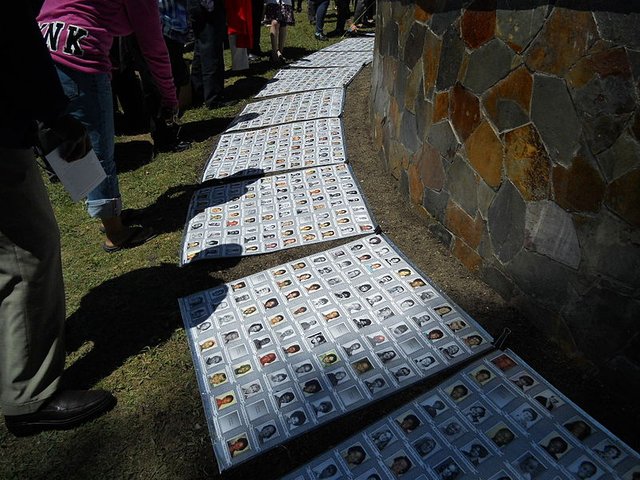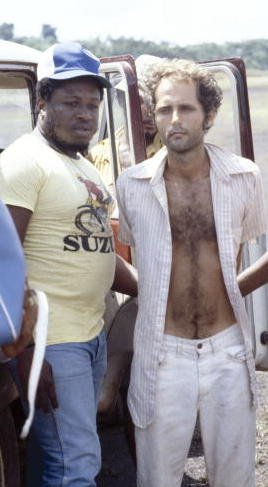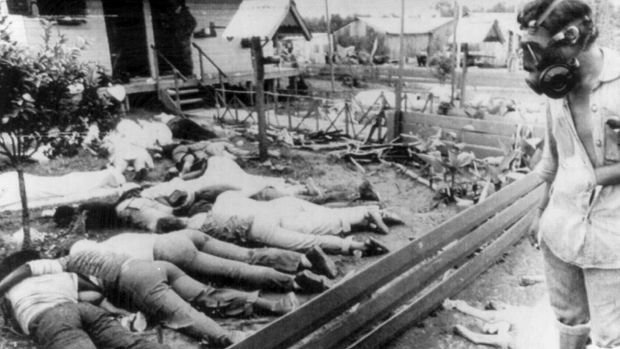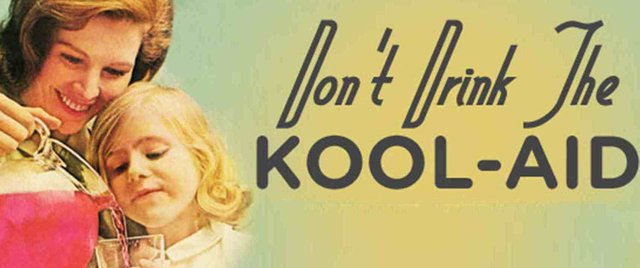Drinking the Kool-Aid: Part Five, The Fallout
Forty years ago, cult leader Jim Jones persuaded over 900 hundred people to commit suicide. What was the aftermath, and what was the legacy of the Jonestown Massacre?
This is the final post in the series on the events leading up to The Jonestown Massacre on 18 November 1978. For details on the triggers for the massacre and the mass-suicide itself, please see Drinking the Kool-Aid: Part Four, Revolutionary Suicide.

Pictures of those who died in Jonestown laid out at a 2011 memorial service
The dead
909 people lay dead in Jim Jones' promised socialist paradise, carved out of a jungle in Guyana. There must have been an eerie silence once all the screaming and crying stopped. The children had been the first to go, poisoned to death by their mothers. All 304 of them. Jim Jones had told them to drink the poison, and they obeyed. To get to the point where you would obey someone who tells you to commit suicide and poison your own children too, can only mean your mind would be bent and controlled to the point that you lost your own free will. This wasn't a voluntary “revolutionary suicide”. It wasn't even a leap of faith in a promised hereafter. It has been correctly called the “Jonestown Massacre”.
The massacre was triggered by the killing of Congressman Leo Ryan, and four others at the airstrip in Port Kaituma, 10 km from Jonestown. They were left lying next to the plane that was supposed to take them to safety.
The suicides didn't only happen in Jonestown. Sharon Amos was a Temple member working at the Peoples Temple headquarters in Georgetown. As the suicides began, she received an instruction from Jonestown that members at the headquarters were to take revenge on the Temple's enemies and then commit revolutionary suicide. When police arrived at the headquarters, Sharon Amos escorted her children, Liane (21), Christa (11), and Martin (10), into a bathroom. There she stabbed Christa to death with a kitchen knife, followed by Martin. Then Liane assisted Sharon in killing herself with the knife, after which Liane killed herself with the knife.
All-in-all, 918 people had died that day.
Escapes
But there was some movement. At least seven of the people in Jonestown that evening survived. An elderly, hearing-impaired man missed the announcement to assemble. When he saw what was going on, he lay down in a ditch and pretended to be dead. Hyacinth Thrash was an elderly woman who slept inside her cabin throughout the whole ordeal. She woke up the following morning and walked over to a senior citizens’ building where she saw bodies covered in sheets. Her sister Zipporah Edwards was among the dead.
Jones' two lawyers managed to get past the guards and hid in the jungle. A man named Odell Rhodes managed to escape after witnessing the suicides taking place. Much of the testimony about the events that evening was provided by Rhodes.

Two elderly survivors
Three members escaped death when, before the suicides began, they were sent on a mission to take hundreds of thousands of dollars to the Soviet embassy in Georgetown, capital of Guyana. They carried letters bequeathing in excess of $7.3 million to the Communist Party of the Soviet Union. They ditched their mission as soon as they heard what was happening in Jonestown. One of them, Tim Carter, rushed back desperately looking for his son only to witness him being poisoned, and his wife killing herself in despair. Carter had a complete nervous breakdown and was pulled away by his brother who had accompanied him on the mission.
Port Kaituma
Meanwhile, at the airstrip in Port Kaituma, five dead bodies lay sprawled on the runway, including that of Congressman Leo Ryan. The wounded and others were left to fend for themselves. It took many hours before they gathered themselves together. They were joined later that night by Odell Rhodes. Those badly wounded were placed in a tent next to the runway while the others found shelter at a nearby café.
Larry Layton, who had fired a gun at several people aboard the first plane, had sneaked back to Jonestown to collect his passport. Richard Dwyer, a close colleague of the murdered Congressman Leo Ryan, had assumed a leadership role and had the local police arrest Layton.

Larry Layton under arrest, with Vern Gosney (L)
The next morning, 19 November 1978, a Guyanese government plane arrived to evacuate the wounded.
The gruesome reality
At the same time, officials arriving at Jonestown were greeted with the haunting sight of the hundreds of dead bodies sprawled around the pavilion.
Three days later, Tim Chapman, a photographer from the Miami Herald got to Georgetown and talked his way onto a helicopter going to Jonestown. The bodies were still lying there, unmoved. At 300 ft off the ground, he was hit by a terrible stench. What he saw on the ground still haunts him to this day. He had a chamois over his nose and mouth but the smell of rotting corpses was unbearable. Almost all the other reporters couldn't take it and took off to other parts of the settlement, but Chapman bit down on the chamois and worked his way through the bodies, taking pictures as he went.

Chapman refused to take pictures of Jones' bloated body—he wasn't going to memorialise him in any way. What struck him, was the arrangement of the bodies. Jones was lying on his back while most of the others were lying face down, their heads pointing to Jones.
“I could tell,” Chapman said, “that it wasn’t their final statement. It was Jones’.”
The aftermath
A suit by ex-members Tim and Grace Stoen against Jim Jones to retrieve custody of their son, John, had been a major cause of Jones' paranoia of being attacked, leading finally to the mass-suicide. There are specific references to Tim Stoen in the final “death tape”, particularly how they could murder him, and a discussion over whether John Stoen (the son) should be among those committing “revolutionary suicide”. John Stoen was found poisoned in Jim Jones' cabin in Jonestown.

John Victor Stoen
Larry Layton was initially found not guilty of attempted murder in a Guyanese court, his defence being that he was “brainwashed”. Since he couldn't be tried in the US for the attempted murders aboard the plan, he was tried under a federal statute against assassinating members of Congress and internationally protected people (Ryan and Dwyer). He was convicted of conspiracy and of aiding and abetting the murder of Ryan and of the attempted murder of Dwyer. Paroled in 2002, he is the only person ever to have been held criminally responsible for the events at Jonestown.
The event was a media sensation. Pictures and articles of appeared widely for months after it occurred. Both Time and Newsweek magazines labelled it a “cult of death”. In February 1979, 98% of Americans polled said that they had heard of the tragedy. George Gallup stated that “few events, in fact, in the entire history of the Gallup Poll have been known to such a high percentage of the US public”.

Time Magazine cover, 4 December 1978 image: Time
The Cult Awareness Network, a group aimed at “deprogramming” members of cults, was formed soon after the Jonestown deaths. The group, which included Congressman Ryan's daughter Patricia, was involved in various personal, social and legal battles with a range of religious organisations, from The Family International and Scientology to David Koresh's Branch Davidians where they heavily influenced how the children of the Waco siege were treated.
Because of the sheer scale of the event, conspiracy theories flourished, particularly that the CIA was somehow involved. It reached the extent where a Congressional committee investigated the claims and later announcing that there was no evidence of CIA involvement at Jonestown.
The Kool-Aid
Jones' poison was mixed with a drink called Flavor Aid, presumably to make it more palatable. This was commonly—and mistakenly—referred to as Kool-Aid. This led to the phrase “drinking the Kool-Aid”, meaning a true believer and blindly following the leader. It's the holding of an unquestioned belief, argument, or philosophy without critical examination. It's blind, unquestioned obedience.
So perhaps the biggest legacy of the Jonestown massacre is that, more often than not, the phrase used is: “Don't drink the Kool-Aid”.

image
Previous posts in this series:
Drinking the Kool-Aid: Introduction
Drinking the Kool-Aid: Part One, The Making of a Cult
Drinking the Kool-Aid: Part Two, Total Control
Drinking the Kool-Aid: Part Three, The Promised Land
Drinking the Kool-Aid: Part Four, Revolutionary Suicide
References:
https://jonestown.sdsu.edu/?post_type=who_died
https://www.rollingstone.com/culture/culture-news/in-the-valley-of-the-shadow-of-death-guyana-after-the-jonestown-massacre-242259/
https://www.nytimes.com/1988/11/18/us/ghost-of-jonestown-haunts-survivor.html
https://hazlitt.net/longreads/how-did-happen-and-how-did-i-not-see-it-coming
https://en.wikipedia.org/wiki/Jim_Jones
https://en.wikipedia.org/wiki/Jonestown